Orbán is a tool in Putin's information war against the West
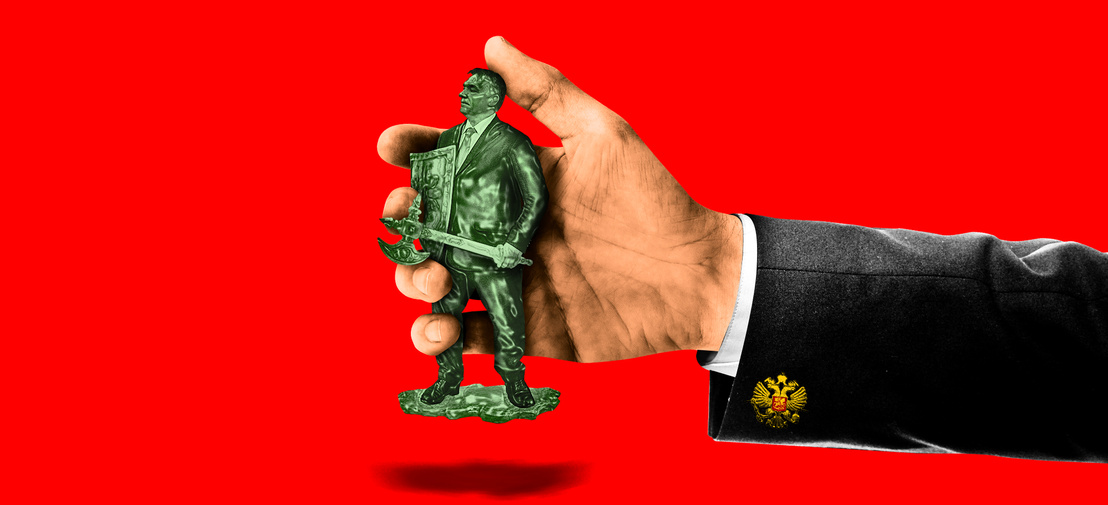
- Czech analysts found after investigating 22,000 Russian-language online sources that Moscow’s propaganda started two years before the military intervention in the case of Ukraine and four weeks in advance concerning Syria. First came the journalists, then tanks and bombs.
- From the 2010s the Russian army and its military intelligence service started dominating the control of Russian propaganda; thus, whatever is published in the 90% state-dependent Russian media is part of the Russian Federation’s military strategy.
- Semantic Visions, a Czech company also examined the role played by European leaders, including Viktor Orbán, and the results are worrying. The Kremlin-controlled Russian media uses politicians voicing an anti-EU and anti-West rhetoric to legitimise the Putin's regime.
- We introduce spectacular analyses on the schemings of Russian secret services.
An EU head of state holding a bilateral meeting with Vladimir Putin three times in two years is unparalleled in the period following the eruption of the Ukraine crisis and the annexation of Crimea in 2014. The Russian president’s meeting with Hungarian Prime Minister Viktor Orbán on February 2 marked exactly the third time the two sides met, which suggests a special relationship exists between them. It indicates that the Hungarian government follows a pro-Russian foreign policy within the framework set by the EU, which Moscow acknowledges and reciprocates on the diplomatic level.
Several articles and analyses have been published about the radical pro-Russian turn of Viktor Orbán since his ascension to power in 2010 after having been strongly opposed to communism during the democratic transition and strongly critical of Russia even in 2008 at the time of the Georgian War. The turning point was in November 2009 when Viktor Orbán travelled to Saint Petersburg to attend the congress of United Russia. Viktor Orbán, then an opposition politician, met Putin for a 15-minute-long informal discussion. The meeting was set up with the involvement of the notorious pro-Kremlin former ambassador to Moscow, Ernő Keskeny.
What happened during the discussion has been a mystery ever since, but Viktor Orbán and Fidesz’s defining anti-Russian stance evaporated from that point onwards. Upon his return from Saint Petersburg, on MTV’s (the Hungarian public news channel's) programme entitled Today Morning (Ma Reggel) aired on November 25, 2009 Orbán practically handed the refurbishment of the Paks nuclear power plant to the Russians, stating:
This is a Russian-type plant. We cannot refurbish it without the Russians, we cannot leave them out of it even if we want to build a new one.
All this was uttered years before the tender was actually published, even before the electoral victory of Orbán in 2010.
The pro-Russian or at least strongly pragmatic statements, viewpoint and measures of the second and third Orbán governments are well-documented. How Orbán and his party, Fidesz and their media empire thinks about Russia is largely common knowledge. One can only question motives: how big a role geopolitical necessities, economic interests, ideological sympathies, the corruption and blackmailability of the Hungarian political elite or influence exerted by Russian secret services play in this is up for debate.
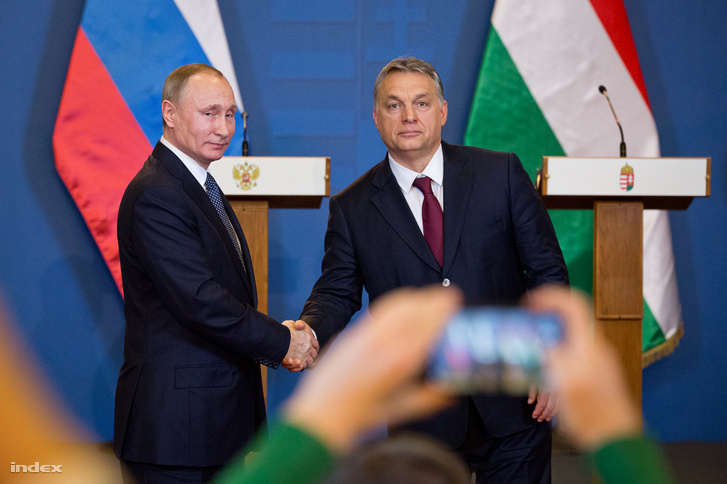
In our article, we describe how Orbán is presented in Russian-language media using a big data analysis based on an Open Source Intelligence (OSINT) method, conducted by a Czech risk assessment company. In the Russian media which is – one way or another – 90% state-dependent and broadcasts the Kremlin’s propaganda. The propaganda that is a part of Russian information warfare and, as such, controlled by the Russian army and the military intelligence service, the GRU (Glavnoye Razvedyvatel'noye Upravleniye).
Other stories on Russian influence in Hungary
Lieutenant chief section editor ready for service
According to the Moscow Times, in May 2014 Russian President Vladimir Putin decorated more than 300 journalists for their “objective” reports on the annexation of Crimea – which the Kremlin’s spokesperson admitted to, but he did not want to elaborate on the topic. This is not a coincidence: such Russian ceremonies are not similar to events when, for example, the Orbán government decorates a friendly, pro-government journalist. What we have called Russian propaganda in Europe for a long time has been categorised as “information warfare” by the Russian Federation’s military doctrines. What we believe to be propaganda journalism, political PR or country image improvement is the integral part of the Russian army’s military strategy for Moscow.
Russia expert András Rácz pointed out to Index that information warfare has been a part of Russian military thinking since the 80s and, consequently, it has constantly been improved. Regarding contemporary ideas on the topic, he believes it is worth it to have a look at the military lexicon, which is available online as well, entitled Voina I Mir (War and Peace) published back in 2011 and edited by Dmitry Rogozin, a Russian pro-government politician and former permanent representative to NATO (!) who is famous for his provocative actions.
The book lists weakening the opponent’s governmental defence capability and its military power, breaking its fighting morale and trust in military leadership, discrediting political leadership, provoking “controlled crises” and staggering the population’s mood as potential goals of information warfare. An integral part of information war is the moral and psychological training of one’s own population to prepare them for war, including the formulation of a depiction of the enemy.
The new Russian military doctrine approved three years later in December 2014 considered information warfare to be equal to ground, air and naval warfare. Consequently, the importance of the field is also indicated by the allocation of resources
– said András Rácz. In practice this means journalists only differ from an armoured division in that they fight the enemy on another field. The deployment of journalist brigades is quite simple because around 90% of Russian media is either directly owned by the state or strongly dependent on it.
A study on Russian information warfare (.pdf) written by Jolanta Darczewska for the Centre for Eastern Studies (OSW) in Warsaw highlights that the “information weapons” Russia uses against the West were tested internally in advance. The Kremlin first established the “single information space of the Russian Federation”, which mainly means that they started to regulate publicity through tough rules and took control of major media outlets. The test of information weapons in reality involved cyberattacks against Russian civil society organisations, opposition activists and on the grounds of fighting extremism they ordered opposition media outlets and social media to be shut down.
“The protection of domestic information space is so important to Moscow it created a separate information security doctrine in December 2016. The document does not only elevate the previously followed, more and more restrictive practice to the political level, but it forecasts further restrictions as well” – recalled András Rácz. The quoted Polish study states that for a long time Russian (civilian) intelligence services were the only ones responsible for Russian “information security”, but this changed in the early years of this decade.
For instance, this also explains why hacking the Democratic National Committee in the US or the takeover of the Hungarian far-right MNA’s website and its reorganisation as a propaganda site fell under the competence of Russia's military intelligence, the Main Intelligence Directorate of the General Staff, commonly known as GRU and why not the KGB's successors, the SVR and FSB got exclusive rights to perform these missions.
First the journalists, then tanks and bombs
Semantic Visions is a risk assessment company based in Prague, which works for private companies, non-profits and think tanks as well as Czech state institutions. They conduct their big data (meaning non-structured, large data requiring serious calculations) analyses with the aid of open source intelligence, on the foundation of which they try to identify trends or risk factors. The company previously conducted analyses on the reaction after the Charlie Hebdo attacks, the US presidential debates and how European leaders are depicted in Russian propaganda.
Semantic Visions included more than 400,000 online sources, including 22,000 Russian ones in its research: they had algorithms read online articles searching for different trends. They conducted numerous analyses that undoubtedly and spectacularly prove connections between Russian propaganda and the actions of the Russian army. With the approval of Semantic Visions, we introduce two of their not yet published studies that show how the Kremlin’s information war prepared the ground for Russian military intervention in Ukraine and Syria.
The period shown on the first chart starts in June 2011 and ends in February 2014: the revolution overthrew pro-Kremlin President Viktor Yanukovych at that time, after which Putin gave the order to annex Crimea. “Little green men” showed up in Crimea at the end of February 2014, which were unidentifiable, masked soldiers armed with Russian weapons. The graph shows how many Russian (red columns) and English (blue columns) articles with a negative tone on Ukraine had been published in the more than two and a half years before this event. It is obvious immediately that even in the beginning of the period under review there were more Russian-language articles that spoke negatively about Ukraine than there were English ones in Western/global media.
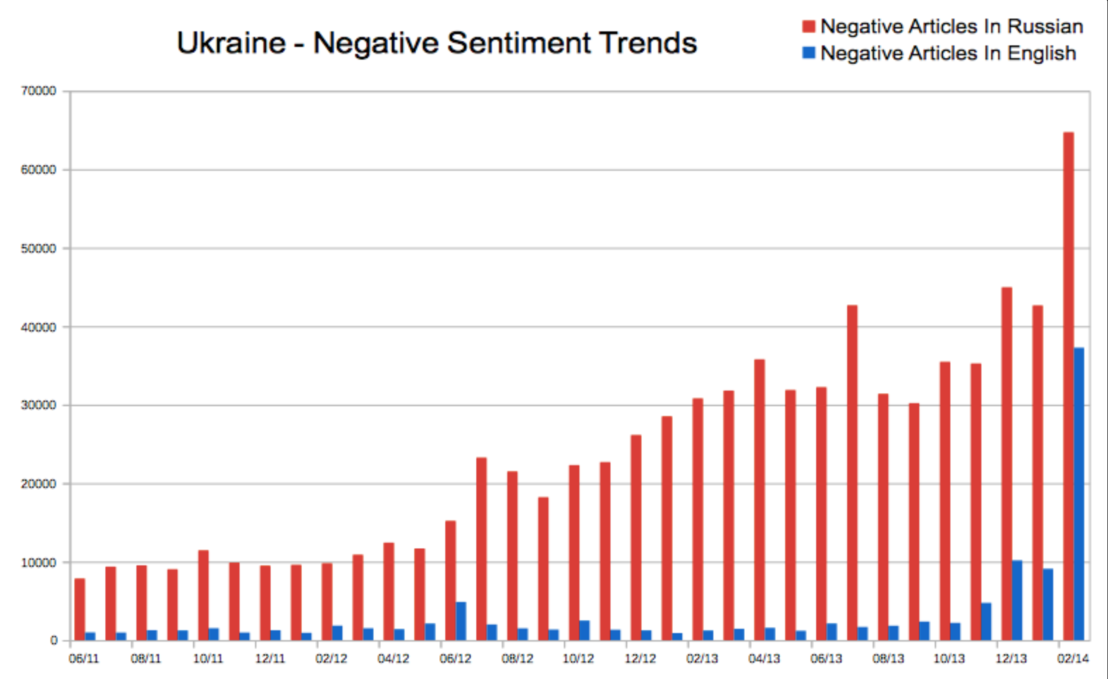
However, this is not the most interesting finding. What really catches our eyes is the process the origins of which can be traced in Semantic Visions’ big data analysis from February 2012. The number of Russian articles with a negative tone on Ukraine at that point started to show a gradual and trend-like increase – while no similar trend can be found in English-language media. Therefore, based on hundreds of millions of articles the possibility that the actual events in Ukraine could themselves be the reason for the increasing combativeness of Russian-language articles can be excluded. Moreover, the strongly pro-Russian President Yanukovych was still in government at the time and the similarly Eastern-oriented Party of Regions was in power. The explanation is something else: the Putin administration was consciously preparing for military intervention and
The Czech company looked for some control sample, so they viewed how articles in Russian and English reported on the 2014 Winter Olympics in Sochi and the two matched each other in this regard, therefore, no unique Russian trend was visible in terms of the content of Russian articles on the Olympics.
The CEO of Semantic Visions Frantisek Vrabel told Index they had a separate study on how Russian- and English-language media reported on the downing of Malaysian flight MH-17 in July 2014. Their study showed that the tragedy immediately became leading news in the English-language media, while Russian internet wrote about the topic after significant delay and in a considerably smaller number of articles – which is very revealing.
The company’s similar big data analysis found a connection between intensifying Russian propaganda and Moscow’s military actions in the case of another military intervention. On the chart below you can see how the number of Russian articles on Syria changed daily from early 2014 to spring 2016.
While Syria was a highly featured topic in English-language media consistently, in Russia the events were followed with relative languidness. Neither an increasing nor a decreasing trend is visible in the number of reports on Syria – up until September 2015, when the article count started to rise rapidly. The analysis found that the four weeks before the first Russian air strike was characterised by a mass production of articles on Syria in Russia.
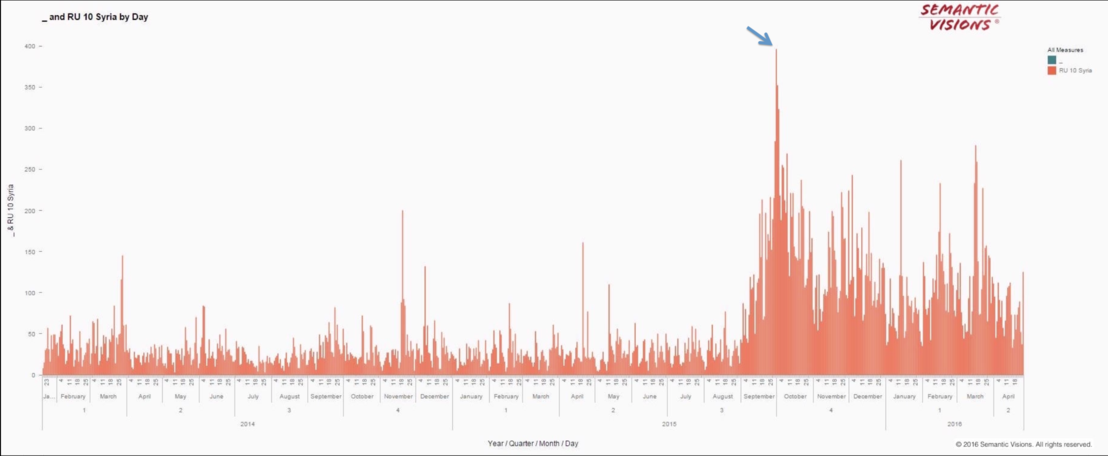
This long introduction and the Ukrainian and Syrian examples were necessary to prove without a doubt that the presence of Hungarian Prime Minister Viktor Orbán in Russian-language media does not depend on Hungarian and European events nor does it depend on the professional decisions of the journalists of the free Russian press. Instead, it is dependent on the guidance of the Russian army’s secret services, to whom Viktor Orbán is only a tool in their information war against the West. And as we will see, he is not an insignificant tool.
Zeman, Orbán, Fico: Moscow’s Trojan horses
Semantic Visions and European Values Think-Tank, a Prague-based institute fighting Russian influence performed a similar data analysis (.pdf) to map in what way and how often important European politicians are mentioned in Russian propaganda. In the period they reviewed, between January 20, 2014 and May 15, 2016, they analysed 59,983,045 documents (articles) from 22,463 Russian-language sources.
They found that "instead of the representatives of the European Union, the leaders of the big European states, especially the German Chancellor and the French President, are perceived by the Russian-speaking media as the voices of Europe worthy of dealing with the Russian President Vladimir Putin. "

According to the study of Frantisek Vrabel and the deputy director of European Values Jakub Janda, the Kremlin disinformation campaign "works very hard to portray the European leaders according to their inclination to support Russia. The more favourable those personalities are to Vladimir Putin's regime, the stronger voice in the international community they have according to the Russian-speaking outlets".
One goal of this practice is to show the Russian public that despite sanctions and international criticism Russian President Vladimir Putin has serious supporters and friends in the European Union. Consequently, the Kremlin uses the statements of certain EU politicians to legitimize its own authoritarian regime, propaganda this way also serves Russian national security interests.
The other goal, naturally, is to depict the European Union as a community of constant debate, division and decline on the edge of dissolution in Russian-language media. It uses exactly those European politicians to achieve this aim whose statements include similar messages and/or speak contrary to the European mainstream on issues important to Russia, such as energy, the refugee crisis, NATO, EU sanctions, etc.
Russian propaganda disregards the given politician’s actual political power, influence or the size and importance of the country represented by them, not even the competences and powers they hold matter. This is the case with the Czech Republic’s pro-Russian and anti-EU President Milos Zeman. While Prime Minister Bohuslav Sobotka who holds actual political power and implements a mainstream, pro-Western foreign policy is rarely featured in Russian reports, Zeman with his largely representative function is a real star of these.
Semantic Visions’ big data analysis of the Russian media space proved without a doubt that besides Zeman the Hungarian Prime Minister Viktor Orbán and the Slovakian Robert Fico are also widely overrepresented. The chart below differs from the previous one in that it takes the size of the country’s population into account, as their actual political influence is largely dependent on the size of their country. This way one can find out which EU politicians Moscow favours openly and who are represented non-objectively in the state-dependent Russian media space.
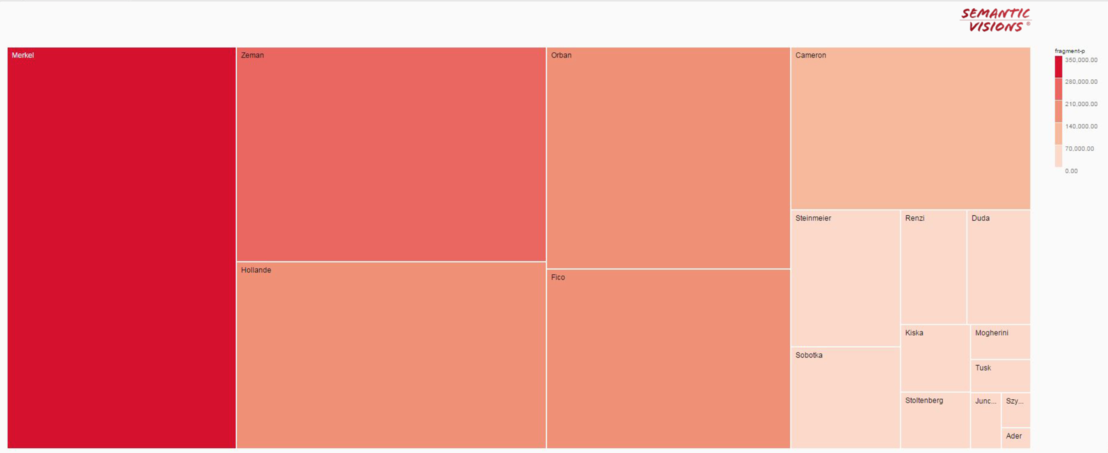
The leading position of the German Chancellor is unassailable in any case, but contrary to the previous graph, Milos Zeman came second, Robert Fico fifth and Viktor Orbán fourth, even though the size of the population of Hungary and the Czech Republic is roughly 6 times lower than that of Great Britain. We can therefore say that the Russian media space favours the Hungarian prime minister and the Czech president and it punishes the former British prime minister who is a hardliner regarding sanctions against Russia. The Czech President is overrepresented around sevenfold compared to Angela Merkel, while Viktor Orbán is overrepresented by around five- to sixfold.
Orbán, the Kremlin’s favourite Central European
During the abovementioned research, the Czech risk assessment company also had analyses on European politicians who were not featured in this study. The detailed research on Viktor Orbán has not been published before, but they provided it to Index and we will also introduce these with the approval of Semantic Visions. In this analysis, they investigated the presence of the sitting heads of government of V4 states, namely Poland, the Czech Republic, Slovakia and Hungary, in Russian-speaking media. The examined period (January 2014 and May 2016) and the sources (22,000 Russian-language sources and more than 59 million documents) match the previous one.
Putin can practically call Budapest home
In terms of presidential visits by Vladimir Putin, Orbán’s Hungary has a commanding lead over its partners from the V4. Putin visited Budapest to hold bilateral talks in 2015 and 2017 after 2006. However, he has not been to the Czech Republic in his presidential capacity since 2006, he was in Bratislava once, in 2005 to meet President Bush, and he visited Poland the same year for the first and only time, but only to take part in the memorial ceremony commemorating the liberation of Auschwitz.
The analyses detail the presence of V4 prime ministers, namely Slovakian PM Robert Fico (bright green columns), Hungarian PM Viktor Orbán (blue), Czech PM Bohuslav Sobotka (orange) and – after her candidacy and inauguration in 2015 – Polish PM Beata Szydlo (green) in Russian media in comparison to each other based on different aspects. It must be taken into account during the interpretation of the charts that Szydlo’s ascension to power came later, three-fourth through the examined period.
On first the chart showing monthly trends it is clearly visible that during the 29 months of the examined period Viktor Orbán got the most mentions among the V4 prime ministers (V3 until the emergence of Szydlo) in almost half of them, precisely in 14 months and in 8-9 cases with a staggering difference. Trends show that Viktor Orbán played a crucial role in Kremlin propaganda already back in 2014 during the Ukraine crisis and then there were two large increases, the first at the time of Putin’s first visit to Budapest in February 2015 and the second at the peak of the refugee crisis in September 2015. In the first half of 2016 one can notice a kind of balance setting in with the emergence of Szydlo, but Orbán still gets disproportionally large attention compared to the prime minister of the four times bigger but traditionally anti-Russian Poland.
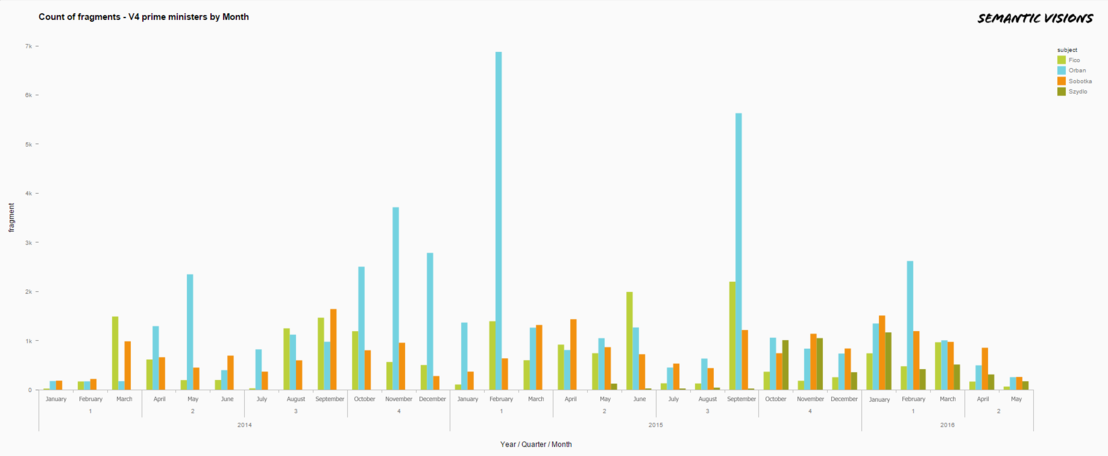
Semantic Visions investigated the attention given to V4 premiers with regards to a variety of different topics in comparison to each other in the Russian media space. We are now introducing four of these in detail: energy, extreme right, migration and the Ukraine crisis. Among these four three are included in the most important topics in which the Czech company examined mentions of Central European prime ministers, the case of the far-right was considered to be marginal.
The separate analysis of the topics is important because one would naturally think that Orbán is overrepresented in Russian media because of migration and the refugee crisis, but in reality it is not true: except for one issue, he has the lead in every topic among V4 prime ministers.
Energy:
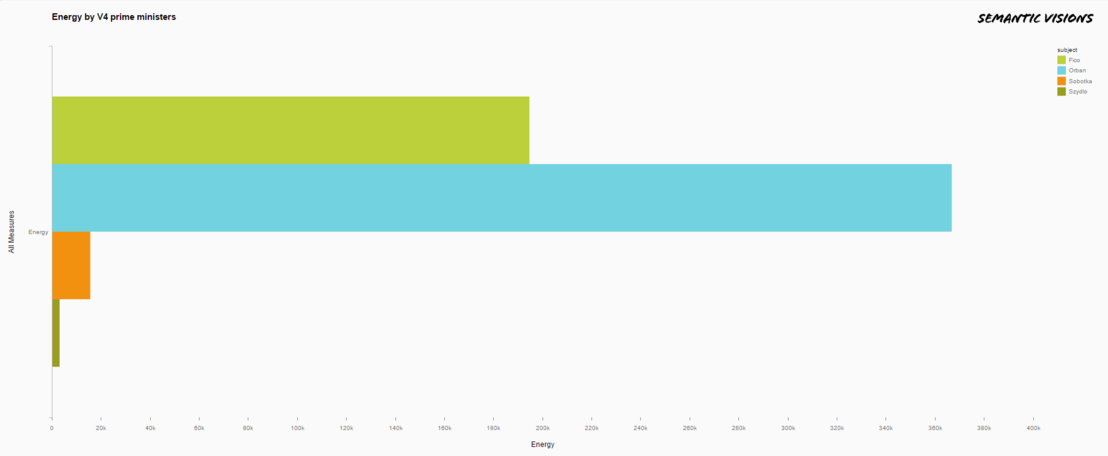
Extreme right:
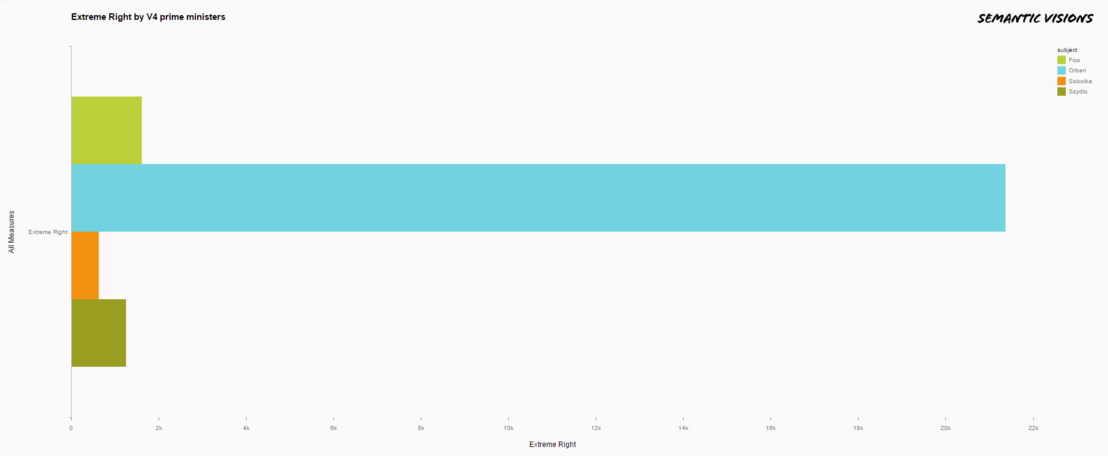
Migration:
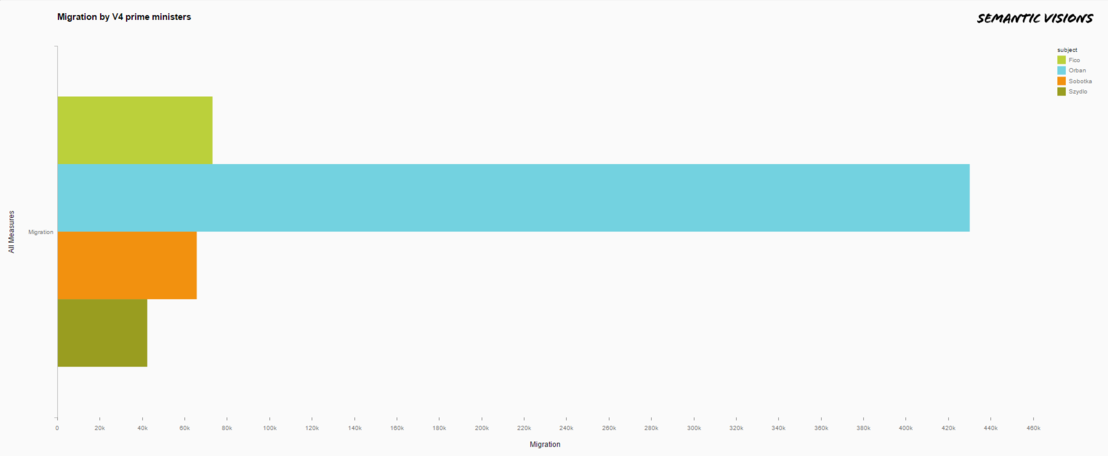
Ukraine crisis:
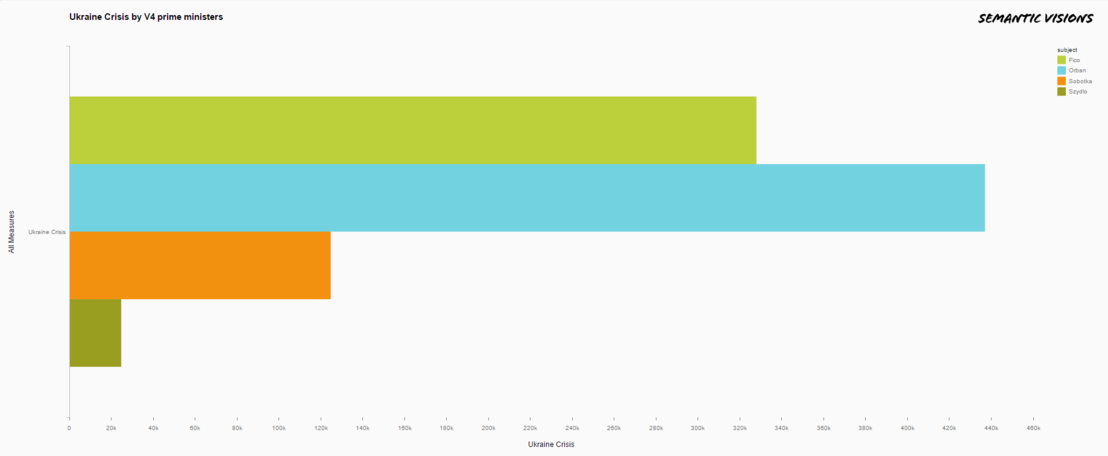
The chart below indicates how the presence of V4 prime ministers is divided in comparison with each other within a given topic investigated by the analysis. Noticeably, Viktor Orbán fails to gain first place in only one issue, where he fell down to third: NATO. Since NATO is naturally featured in a negative context in Russia, it is perfectly logical and suits the trend that the Hungarian prime minister is not the most mentioned individual in this aspect.
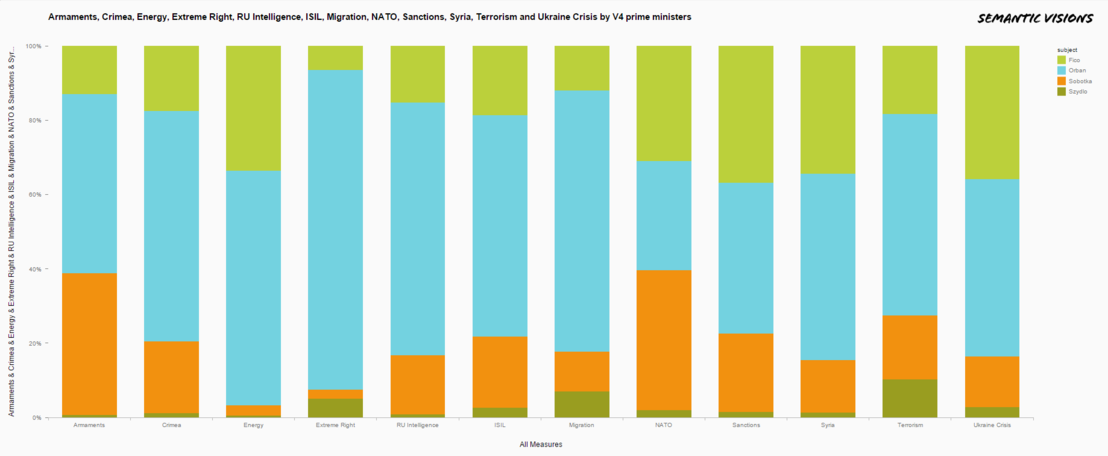
On the last, detailed column chart the weight of certain topics in Russian-speaking media and which V3/V4 prime minister dominated them can be examined. All three topics of significant importance (energy, media, Ukraine crisis) were dominated by Orbán.
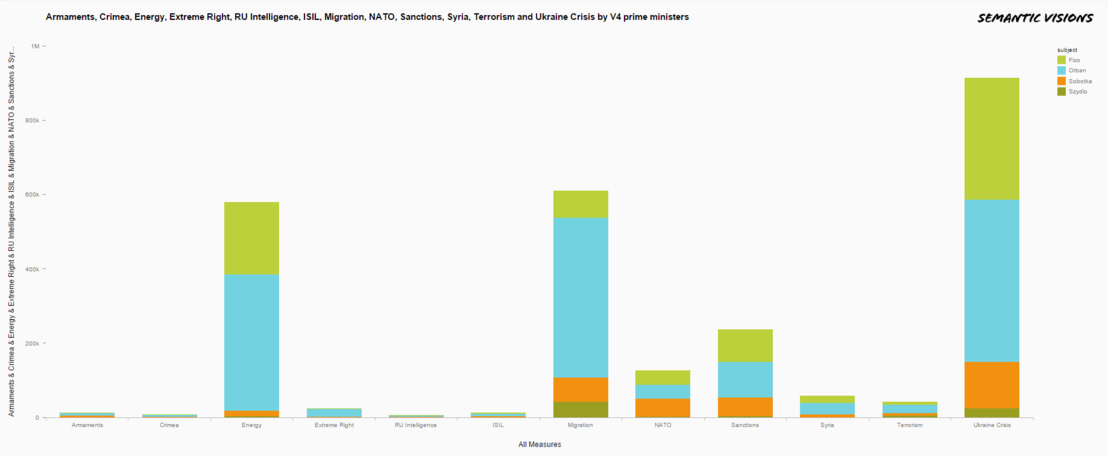
Finally, we introduce three complex graphs drawn by Semantic Visions where the appearance of Orbán and a different V4 prime minister can be viewed next to each other divided by different topics.
Fico and Orbán:
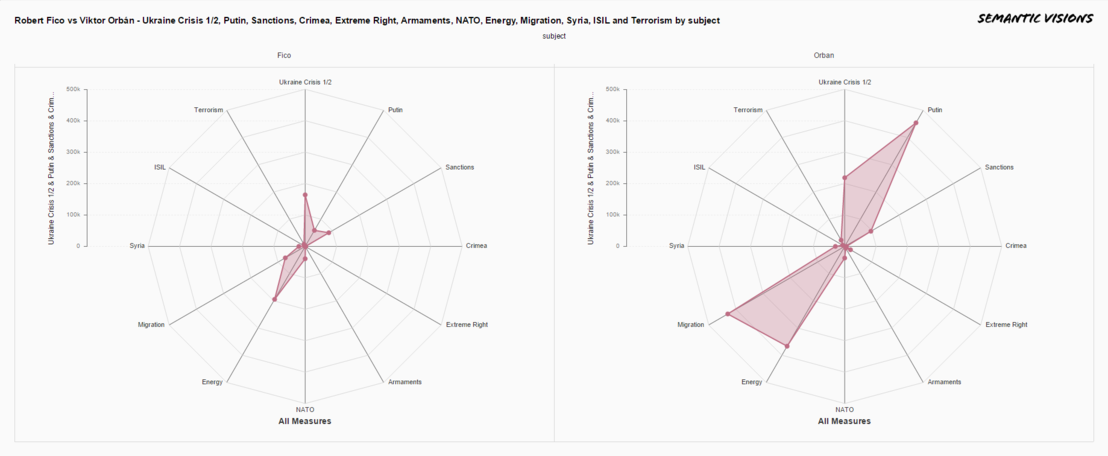
Orbán and Sobotka:
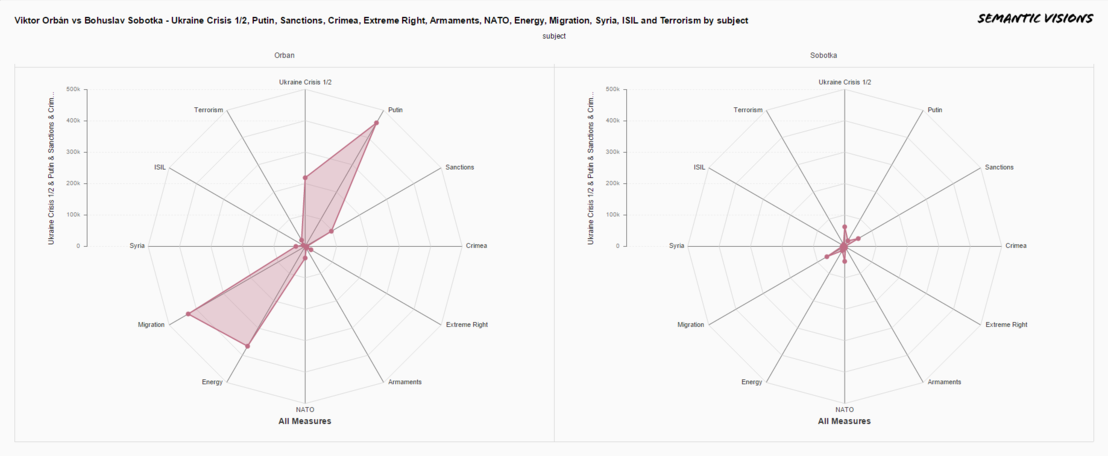
Orbán and Szydlo:
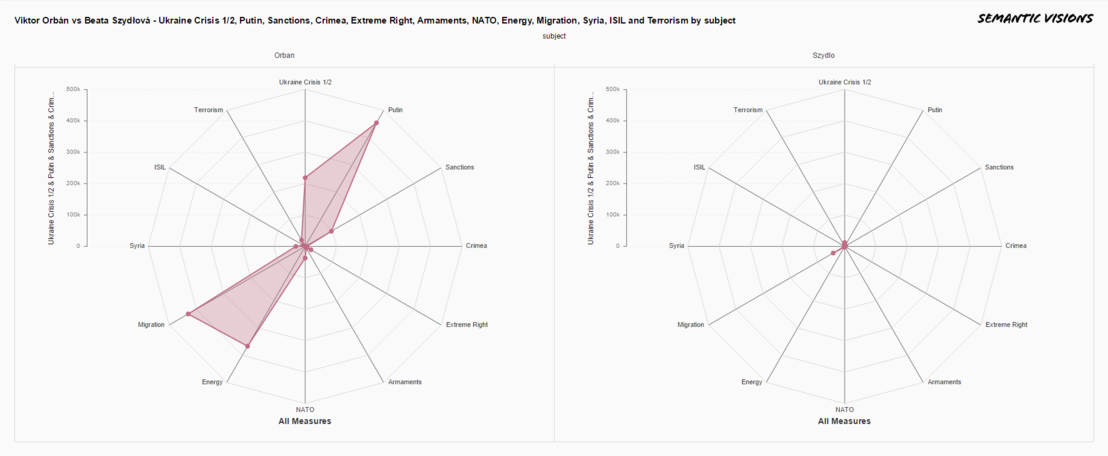
The fact that Russian media pays disproportionate attention to Viktor Orbán and Hungary is not a problem in itself. However, the Kremlin does this to advance its own interests as part of a military strategy that considers NATO to be an enemy. Naturally, not only the Czech analysts realised this, the Hungarian state must be certain about it as well.
We are part of their attack on the West
The Hungarian Ministry of Foreign Affairs and Trade’s (KKM) research institute and think tank, Institute for Foreign Affairs and Trade investigated in a recent study published in January how Hungary was depicted in Russian and Ukrainian media last year (.pdf). Beatrix Tölgyesi’s content analysis examined four Russian media outlets (RIA Novosti, Regnum, SputnikNews, RuBaltic) between April 15, 2016 and October 15, 2016. Since all four outlets are state-owned, Tölgyesi says that “based on their news stories we can draw conclusions regarding the Kremlin’s information politics”.
The conclusion of the analysis is crystal clear, Russian propaganda does not attack Hungary, but uses the country to fight the EU and Western values, and additionally it tries to generate tensions in the region using topics connected to Hungarians:
For the Russian audience our nation is part of the anti-EU/NATO propaganda.
Hungary-related manipulation is not as prevalent – only 7-8% of the articles are lopsided –; thus, we cannot categorise this an information attack against us. Hungary is less of a priority in Russian foreign policy compared to Poland or Romania. In the stories intended for Western audiences they use us to attack Western political and cultural values. In this regard the share of strongly lopsided anti-Hungarian news is 15%, which can be evaluated as an information attack. For the population of other countries in our region they very often write about Hungarian-related topics to incite hatred and increase uncertainty: more than 20% of the articles about us are lopsided. In this area, we can talk about a threatening information war” – evaluates the document.
The study of the Institute for Foreign Affairs and Trade finishes with this sentence:
Information attacks affecting our nation are focused on a small number of commonly known topics, they can be typified, meaning that they can be foreseen; thus, it is possible to plan a defence against them. In our region there are nations and publics much more severely affected by information attacks, therefore, it is a common interest to step up jointly in a regional alliance against this phenomenon.
This article was originally published in Hungarian. Translated by Patrik Szicherle.
(Illustration by szarvas / Index)

Support the independent media!
The English section of Index is financed from donations.


